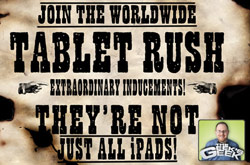7 Lessons Learned From the Tablet Gold Rush
At the moment he unveiled the iPad last winter, Steve Jobs sparked a tablet gold rush. Just as with the Netbook Goldrush of 2007-8, small unknown players are rushing into the fray much faster than their well-heeled counterparts. Over the past few months, we've seen the puny prospectors Augen, CherryPal, CTL, and Netbook Navigator roll their wagons westward while huge PC players like Acer, ASUS, Sony and Lenovo sit quietly on the sidelines and the likes of HP and Toshiba stick their toes in the water by quietly releasing limited-edition slates.
What have these large companies learned by watching the intrepid 2010-ers mine for ore?
- Using a cut-rate resistive touchscreen is harder than digging through solid quartz with your fingernails. If you want consumers to run away screaming, force them to pound with all their might on the display just to type a single letter. After they develop repetitive stress injury from pushing against the hard surface and hearing damage from the squeaking noise the plastic makes, they'll be sure to recommend your product.
- If you don't have apps, you're selling fool's gold. Even though iPad users spend a plurality of their time browsing the web, 85 percent of them have installed 10 or more apps. Users want the ability to customize their tablet experiences and they shouldn't be forced to sideload or hack their devices to get what they want. With its Nvidia Tegra 2 chip, capacitive display, and front-facing camera, the Viewsonic G Tablet sounds good on paper, but Android Market is not supported. If you're selling an Android device that has no marketplace, you might as well get in the stage coach and head back East.
- Stock Windows isn't ready. Unless you have digits the size of toothpicks, the Windows 7 user interface simply doesn't work for finger input. The icons and widgets are just too small, and the concept of having multiple windows on the screen at once isn't relevant on a slate. Innovators like ExoPC have shown that the Windows 7 operating system can work on slates, if you cover it with a really good shell.
- One size doesn't fit all. Consumers have shown that they're interested in a wide range of tablet sizes and formats, including the 7-inch Samsung Galaxy Tab. RIM's 7-inch BlackBerry PlayBook is also generating a lot of interest from consumers and business customers alike. You just have to provide a compelling user experience.
- Tablet users want to travel light. Weight and battery life matter a whole lot. Users may like the large screen on an 11.6-inch device like the ExoPC Slate, but its 2.2-pound weight is an issue. The now defunct (with the exception of vertical markets) JooJoo from Fusion Garage measured 12 inches and weighed a whopping 2.4 pounds. A weight below 1.5 pounds and a battery life of over 6 hours should be table stakes in this game.
- Don't charge more than Apple. AT&T is charging $50 more for the Samsung Galaxy Tab than the iPad, and Netbook Navigator is actually demanding hundreds more for a device with a resistive touchscreen and short battery life. If you want to compete, you have to meet or beat Apple on price. Humble Augen and CherryPad have shown us that a company can sell a tablet for under $200. If they only had capacitive touchscreens and good preloaded markets, they'd really have something. A bigger player will probably learn from this and release a high-quality, low-cost slate in 2011.
- There's still room for real keyboards. The iPad is huge today, but other companies can build wildly successful slates that take a different path. Imagine how much better the swiveling Inspiron Duo might be if it ran the next version of Android and was powered by an ARM processor. We also see room for slates that offer pen input, provided it gets paired with the right apps.
As with prior gold rushes, the excitement of the Tablet rush of 2010 will eventually ebb as smaller prospectors drop out and larger companies grab their territories. But all these failed ventures will lead to huge successes for those who watch carefully. Just as the underwhelming OLPC XO showed us that an inexpensive ultraportable was possible and the contemptible Cloudbook was the first to employ a large hard drive, today's lackluster tablets have much to teach.
Sign up to receive The Snapshot, a free special dispatch from Laptop Mag, in your inbox.


